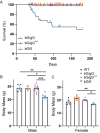Nucleotide- and Protein-Dependent Functions of Actg1
- PMID: 35594181
- PMCID: PMC9582642
- DOI: 10.1091/mbc.E22-02-0054
Nucleotide- and Protein-Dependent Functions of Actg1
Abstract
Cytoplasmic β- and γ-actin proteins are 99% identical but support unique organismal functions. The cytoplasmic actin nucleotide sequences Actb and Actg1, respectively, are more divergent but still 89% similar. Actb-/- mice are embryonic lethal and Actb-/- cells fail to proliferate, but editing the Actb gene to express γ-actin (Actbc-g) resulted in none of the overt phenotypes of the knockout revealing protein-independent functions for Actb. To determine if Actg1 has a protein-independent function, we crossed Actbc-g and Actg1-/- mice to generate the bG/0 line, where the only cytoplasmic actin expressed is γ-actin from Actbc-g. The bG/0 mice were viable but showed a survival defect despite expressing γ-actin protein at levels no different from bG/gG with normal survival. A unique myopathy phenotype was also observed in bG/0 mice. We conclude that impaired survival and myopathy in bG/0 mice are due to loss of Actg1 nucleotide-dependent function(s). On the other hand, the bG/0 genotype rescued functions impaired by Actg1-/-, including cell proliferation and auditory function, suggesting a role for γ-actin protein in both fibroblasts and hearing. Together, these results identify nucleotide-dependent functions for Actg1 while implicating γ-actin protein in more cell-/tissue-specific functions.
Figures







References
-
- Artman L, Dormoy-Raclet V, von Roretz C, Gallouzi IE (2014). Planning your every move: the role of β-actin and its post-transcriptional regulation in cell motility. Sem Cell Dev Biol, 34, 33–43. - PubMed
-
- Baarlink C, Wang H, Grosse R (2013). Nuclear actin network assembly by formins regulates the SRF coactivator MAL. Science, 340, 864–867. - PubMed
Publication types
MeSH terms
Substances
Grants and funding
LinkOut - more resources
Full Text Sources
Miscellaneous

